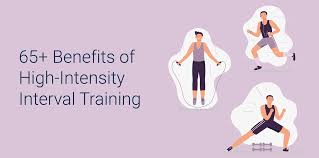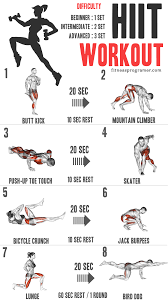The Benefits of High Intensity Interval Training
High Intensity Interval Training (HIIT) has gained popularity in recent years as an effective and efficient workout method. HIIT involves short bursts of intense exercise followed by brief periods of rest or lower-intensity exercise.
Here are some key benefits of incorporating HIIT into your fitness routine:
- Increased Calorie Burn: HIIT workouts are known for their calorie-torching effects. The intense bursts of activity elevate your heart rate and metabolism, leading to a higher calorie burn both during and after the workout.
- Time-Efficient: HIIT workouts are typically shorter in duration compared to traditional steady-state cardio sessions. This makes them a great option for individuals with busy schedules who still want to reap the benefits of exercise.
- Improved Cardiovascular Health: HIIT can help improve cardiovascular fitness by challenging your heart and lungs with intense intervals. Over time, this can lead to better endurance and overall heart health.
- Fat Loss: Research has shown that HIIT may be particularly effective for reducing body fat, including abdominal fat. The combination of high-intensity efforts and post-exercise calorie burn can contribute to fat loss over time.
- Muscle Building: While HIIT is primarily a cardiovascular workout, it can also help maintain or build muscle mass, especially when combined with strength training exercises. This can lead to a more toned and defined physique.
If you’re looking to switch up your workout routine and maximize your results, consider incorporating HIIT sessions into your weekly schedule. Remember to consult with a fitness professional before starting any new exercise program, especially if you have any underlying health conditions.
Get ready to push your limits, boost your metabolism, and experience the many benefits that high intensity interval training has to offer!
Understanding High Intensity Interval Training: Top 6 FAQs Answered
- What is High Intensity Interval Training (HIIT)?
- How does HIIT differ from traditional cardio workouts?
- What are the benefits of incorporating HIIT into my fitness routine?
- Is HIIT suitable for beginners or individuals with lower fitness levels?
- How often should I do HIIT workouts to see results?
- Are there any potential risks or precautions to consider when doing HIIT?
What is High Intensity Interval Training (HIIT)?
High Intensity Interval Training (HIIT) is a popular and effective workout method that involves alternating between short bursts of intense exercise and brief periods of rest or lower-intensity activity. This form of training challenges the body in a unique way, pushing it to its limits during the high-intensity intervals and allowing for recovery during the rest periods. HIIT is known for its ability to increase calorie burn, improve cardiovascular fitness, promote fat loss, and even help build muscle when combined with strength training. Its time-efficient nature makes it appealing to individuals looking for a challenging workout that can deliver results in a shorter amount of time compared to traditional cardio routines.
How does HIIT differ from traditional cardio workouts?
High Intensity Interval Training (HIIT) differs from traditional cardio workouts in its approach to intensity and duration. While traditional cardio exercises typically involve steady-state activities performed at a moderate intensity for an extended period, HIIT alternates between short bursts of high-intensity exercise and periods of rest or lower-intensity activity. This variation in intensity challenges the cardiovascular system in a different way, leading to a more efficient calorie burn during and after the workout. Additionally, HIIT sessions are usually shorter in duration compared to traditional cardio workouts, making them a time-efficient option for individuals looking to maximize their fitness gains in a shorter amount of time.
What are the benefits of incorporating HIIT into my fitness routine?
Incorporating High Intensity Interval Training (HIIT) into your fitness routine offers a multitude of benefits. HIIT is known for its ability to maximize calorie burn in a shorter amount of time compared to traditional cardio workouts. This efficient workout method can help increase your metabolism, improve cardiovascular health, promote fat loss, and even aid in muscle building when combined with strength training. By challenging your body with intense bursts of exercise followed by brief recovery periods, HIIT can elevate your fitness levels, boost endurance, and contribute to overall well-being.
Is HIIT suitable for beginners or individuals with lower fitness levels?
High Intensity Interval Training (HIIT) can be suitable for beginners or individuals with lower fitness levels, but it’s important to approach it with caution and gradually build up intensity. Beginners may benefit from starting with shorter intervals of high intensity followed by longer periods of rest or lower-intensity exercise. It’s essential to listen to your body, pay attention to proper form, and work within your own fitness level to avoid injury. Consulting with a fitness professional or trainer can help tailor HIIT workouts to individual needs and ensure a safe and effective introduction to this challenging yet rewarding training method.
How often should I do HIIT workouts to see results?
To see results from High Intensity Interval Training (HIIT), consistency is key. Most fitness experts recommend incorporating HIIT workouts into your routine 2-3 times per week for optimal results. This frequency allows your body to recover between sessions while still challenging your cardiovascular system and muscles. It’s important to listen to your body and adjust the frequency based on your fitness level, goals, and recovery abilities. Remember that quality of effort during each HIIT session is just as important as quantity, so focus on giving it your all during those intense intervals to maximize the benefits of this effective workout method.
Are there any potential risks or precautions to consider when doing HIIT?
When engaging in High Intensity Interval Training (HIIT), it is important to be aware of potential risks and take necessary precautions. HIIT workouts involve intense bursts of activity that can put a significant strain on the body, especially for individuals who are new to high-intensity exercise or have underlying health conditions. Some potential risks of HIIT include overtraining, muscle strains or injuries, and cardiovascular stress. It is crucial to listen to your body, start slowly, and gradually increase the intensity of your workouts to reduce the risk of injury. Consulting with a fitness professional or healthcare provider before starting a HIIT program is recommended, especially if you have any pre-existing health concerns or limitations. By being mindful of these risks and taking appropriate precautions, you can enjoy the benefits of HIIT while minimizing the chances of injury or overexertion.




